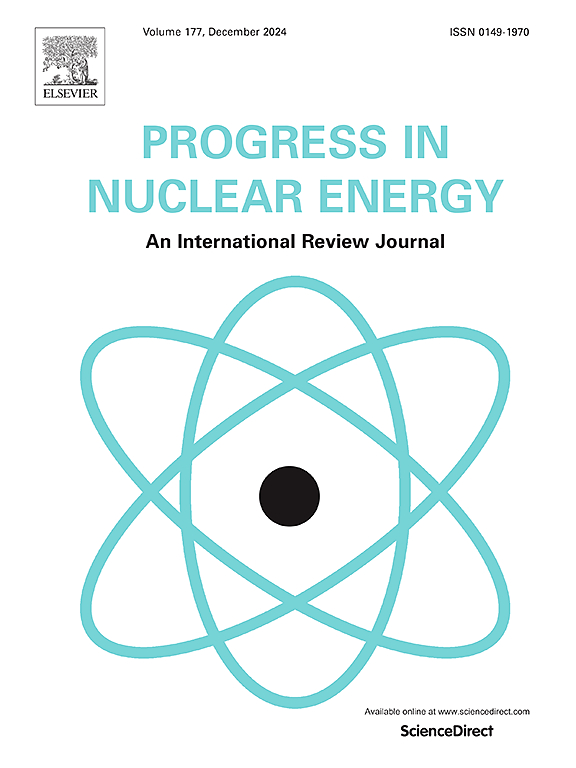Effect of gap size and inclination angle on Critical Heat Flux (CHF) of pool boiling based on bubble behavior observations
IF 3.3
3区 工程技术
Q1 NUCLEAR SCIENCE & TECHNOLOGY
引用次数: 0
Abstract
In this study, the effect of gap size and inclination angles on the Critical Heat Flux (CHF) on bare copper surfaces is investigated in the context of vertical-facing saturated pool boiling. The research endeavor aims to unravel the intricate relationships between these variables and their collective impact on CHF. Through hypothesis formulation and analysis of the collected experimental data, it has been determined that the effects of the two variables, inclination angle and gap size, on CHF are approximately relatively independent. Based on previous research, experimental data has validated the conclusions that CHF increases with both increasing inclination angle and gap size. Furthermore, an empirical formula has been developed that closely aligns with experimental data, incorporating both contemporary experimental findings and established theoretical models. Comparison with previous data and models has shown that it fits well with the derived formula. The author argues that both variables—inclination angle and gap size—have a significant impact on CHF by modulating the Bubble Film Departure Frequency (BFDF) and the average width of bubbles formed during the boiling process. However, these two variables do not directly affect CHF, instead, they influence CHF by affecting bubble behavior. Bubble behavior is the direct factor in the occurrence of CHF, while gap size and inclination angle are indirect factors. Through analyzing bubble behavior, we can gain a better understanding of how gap size and inclination angle influence the average bubble width and BDFM, as well as how the average bubble width and BDFM affect CHF. This research offers reference for IVR strategy implementation: the In-vessel Corium Retention (IVR) strategy, crucial for mitigating core meltdown accidents, ensures the reactor pressure vessel (RPV) lower head remains intact during severe incidents. The Critical Heat Flux (CHF) on the RPV lower head surface is the main barrier to IVR. Consequently, CHF research is essential for IVR application. While there's extensive research on heating surface inclination and gap size effects on CHF, less focuses on bubble behavior. Instead, they influence CHF by affecting bubble behavior. Bubble behavior is the direct factor in the occurrence of CHF, while gap size and inclination angle are indirect factors. Through analyzing bubble behavior, we can gain a better understanding of how gap size and inclination angle influence the average bubble width and BDFM, as well as how the average bubble width and BDFM affect CHF.
本研究以垂直面饱和池沸腾为背景,探讨了间隙大小和倾斜角度对裸铜表面临界热通量(CHF)的影响。研究旨在揭示这些变量之间错综复杂的关系及其对 CHF 的共同影响。通过提出假设和分析收集到的实验数据,确定倾角和间隙大小这两个变量对 CHF 的影响近似相对独立。根据以往的研究,实验数据验证了 CHF 随倾斜角和间隙增大而增大的结论。此外,结合当代的实验结果和已建立的理论模型,还开发出了与实验数据密切相关的经验公式。与以往数据和模型的比较表明,它与推导出的公式非常吻合。作者认为,倾角和间隙大小这两个变量通过调节沸腾过程中形成的气泡膜离去频率 (BFDF) 和平均宽度,对 CHF 有着重要影响。然而,这两个变量并不直接影响 CHF,而是通过影响气泡行为来影响 CHF。气泡行为是影响 CHF 发生的直接因素,而间隙大小和倾斜角度则是间接因素。通过分析气泡行为,我们可以更好地理解间隙大小和倾斜角度如何影响平均气泡宽度和 BDFM,以及平均气泡宽度和 BDFM 如何影响 CHF。这项研究为 IVR 战略的实施提供了参考:舱内铈保留(IVR)战略对于减轻堆芯熔毁事故至关重要,它可以确保反应堆压力容器(RPV)下封头在严重事故中保持完好。反应堆压力容器下封头表面的临界热通量(CHF)是 IVR 的主要障碍。因此,CHF 研究对于 IVR 的应用至关重要。虽然有关加热表面倾斜度和间隙大小对 CHF 影响的研究很多,但对气泡行为的研究较少。相反,它们是通过影响气泡行为来影响 CHF 的。气泡行为是发生 CHF 的直接因素,而间隙大小和倾斜角度则是间接因素。通过分析气泡行为,我们可以更好地理解间隙大小和倾斜角度如何影响平均气泡宽度和 BDFM,以及平均气泡宽度和 BDFM 如何影响 CHF。
本文章由计算机程序翻译,如有差异,请以英文原文为准。
求助全文
约1分钟内获得全文
求助全文
来源期刊

Progress in Nuclear Energy
工程技术-核科学技术
CiteScore
5.30
自引率
14.80%
发文量
331
审稿时长
3.5 months
期刊介绍:
Progress in Nuclear Energy is an international review journal covering all aspects of nuclear science and engineering. In keeping with the maturity of nuclear power, articles on safety, siting and environmental problems are encouraged, as are those associated with economics and fuel management. However, basic physics and engineering will remain an important aspect of the editorial policy. Articles published are either of a review nature or present new material in more depth. They are aimed at researchers and technically-oriented managers working in the nuclear energy field.
Please note the following:
1) PNE seeks high quality research papers which are medium to long in length. Short research papers should be submitted to the journal Annals in Nuclear Energy.
2) PNE reserves the right to reject papers which are based solely on routine application of computer codes used to produce reactor designs or explain existing reactor phenomena. Such papers, although worthy, are best left as laboratory reports whereas Progress in Nuclear Energy seeks papers of originality, which are archival in nature, in the fields of mathematical and experimental nuclear technology, including fission, fusion (blanket physics, radiation damage), safety, materials aspects, economics, etc.
3) Review papers, which may occasionally be invited, are particularly sought by the journal in these fields.
 求助内容:
求助内容: 应助结果提醒方式:
应助结果提醒方式:


